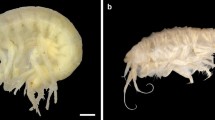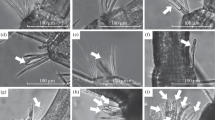Summary
In Asellus aquaticus certain distal antennular segments bear single sensilla referred to as aesthetascs. These show a proximal stem and a distal bulbous region. Depending on its position, each aesthetasc is innervated by either 50–60 or 70–80 bipolar sensory cells, the perikarya of which are situated within the pedunculus. Within the antennular segment the dendrites develop unbranched cilia (9 × 2 + 0 structure). The sensory cells are unusual in that mono- as well as biciliary dendrites are present within a single aesthetasc, the ratio of both types being correlated with the number of sensory cells. Cilia and receptor lymph cavity are enveloped by a set of 3–4 inner and 13–14 outer sheath cells, which terminate at the base of the sensillum, so that the delicate and poreless cuticle of the bulbous region encloses only outer segments within the receptor lymph fluid.
A new molting type in arthropods is described in which the outer sheath cells alone build the new cuticle, whereas the inner sheath cells most probably have a protective function.
A definition of aesthetascs is proposed based on finestructural criteria. Functionally the sensilla are considered to be chemoreceptors. This assumption is confirmed by experiments with diluted vital dye as well as lanthanum showing that dissolved substances penetrate the poreless cuticle instantaneously.
Similar content being viewed by others
References
Ache BW (1982) Chemoreception and thermoreception. In: Bliss DE (ed). The biology of Crustacea 3:369–398. Academic Press, New York
Ache BW, Fuzessery ZM, Carr WES (1976) Antennular chemosensitivity in the spiny lobster, Panulirus argus: comparative tests of high and low molecular weight stimulants. Biol Bull 151:273–282
Altner H (1977) Insect sensillum specificity and structure: an approach to a new typology. In: Le Magnen J, Mac Leod P (eds) Olfaction and taste VI. Information Retrieval, London, p 295–303
Altner H, Prillinger L (1980) Ultrastructure of invertebrate chemo-, thermo-, and hygroreceptors and its functional significance. Int Rev Cytol 67:69–139
Altner H, Thies G (1972) Reizleitende Strukturen und Ablauf der Häutung an Sensillen einer euedaphischen Collembolenart. Z Zellforsch 129:196–216
Altner I, Hatt H, Altner H (1983) Structural properties of bimodal chemo and mechanosensitive setae on the pereiopod chelae of the crayfish, Austropotamobius torrentium. Cell Tissue Res 228:357–374
Andersson A (1975) The ultrastructure of the presumed chemoreceptor aesthetasc “y” of a cypridid ostracode. Zool Scripta 4:151–158
Atema J (1977) Functional separation of smell and taste in fish and Crustacea. In: Le Magnen J, MacLeod P (eds) Olfaction and taste VI. Information Retrieval, London, p 165–174
Crouau Y (1978) Organes sensoriels d'un mysidacé souterrain anophthalme, Antromysis juberthiei: étude ultrastructurale des aesthetascs. Bull Mus Natn Hist Nat Paris 513:165–175
Devine DV, Atema J (1982) Function of chemoreceptor organs in spatial orientation of the lobster, Homarus americanus: differences and overlap. Biol Bull 163:144–153
Dexter BL (1981) Setogenesis and molting in planktonic crustaceans. J Plankton Res 3:1–14
Drach P, Tschernigovtzeff C (1967) Sur la méthode de détermination des stades d'intermue et son application générale aux crustacés. Vie Milieu 18:595–609
Fuzessery ZM (1978) Quantitative stimulation of antennular chemoreceptors of the spiny lobster, Panulirus argus. Comp Biochem Physiol 60:303–308
Fuzessery ZM, Carr WES, Ache BW (1978) Antennular chemosensitivity in the spiny lobster, Panulirus argus: studies of taurine sensitive receptors. Biol Bull 154:226–240
Ghiradella H, Cronshaw J, Case J (1968a) Fine structure of the aesthetasc hairs of Pagurus hirsutiusculus Dana. Protoplasma 66:1–20
Ghiradella HT, Case JF, Cronshaw J (1968b) Structure of aesthetascs in selected marine and terrestrial decapods: chemoreceptor morphology and environment. Am Zoologist 8:603–621
Ghiradella H, Case J, Cronshaw J (1968c) Fine structure of the aesthetasc hairs of Coenobita compressus Edwards. J Morphol 124:361–386
Gleeson RA (1982) Morphological and behavioral identification of the sensory structures mediating pheromone reception in the blue crab, Callinectes sapidus. Biol Bull 163:162–171
Guse GW (1979) Feinstruktur der Aesthetasken von Neomysis integer (Leach) (Crustacea, Mysidacea). Zool Anz Jena 203:170–176
Guse GW (1980a) Development of antennal sensilla during moulting in Neomysis integer (Leach) (Crustacea, Mysidacea). Protoplasma 105:53–67
Guse GW (1980b) Fine structure of sensilla during moulting in Neomysis integer (Leach) (Crustacea, Mysidacea). Experientia 36:1382–1384
Haupt J (1982) Hair regeneration in a solifugid chemotactile sensillum during moulting (Arachnida: Solifugae). Wilhelm Roux's Archives 191:137–142
Haupt J, Coineau Y (1978) Moulting and morphogenesis of sensilla in a prostigmate mite (Acari, Actinotrichida, Actinedida: Caeculidae). I. Mechanoreceptive bristles. Cell Tissue Res 186:63–79
Heimann P (1979) Fine structure of sensory tubes on the antennule of Conchoecia spinirostris (Ostracoda, Crustacea). A new type of sensillum in crustaceans. Cell Tissue Res 202:461–477
Juberthie-Jupeau L, Crouau Y (1977) Ultrastructure des aesthetascs d'un mysidacé souterrain anophthalme. CR Acad Sc Paris 284:2257–2259
Laverack MS, Ardill DJ (1965) The innervation of the aesthetasc hairs of Panulirus argus. Quart J Micr Sci 106:45–60
McLeese DW (1974) Olfactory responses of lobsters (Homarus americanus) to solutions from prey species and to seawater extracts and chemical fractions offish muscle and effects of antennule ablation. Mar Behav Physiol 2:237–249
Reaka ML (1975) Molting in stomatopod crustaceans. I. Stages of the molt cycle, setagenesis, and morphology. J Morphol 146:55–80
Reeder PB, Ache BW (1980) Chemotaxis in the Florida spiny lobster, Panulirus argus. Anim Behav 28:831–839
Rieder N (1978) Die Ultrastruktur der Rezeptoren auf den ersten Antennen von Daphnia magna. Verh Dtsch Zool Ges 1978:299. G Fischer, Stuttgart
Rieder N, Spaniol H (1980) Die Rezeptoren an den ersten Antennen von Leptestheria dahalacensis Rüppel (Crustacea, Conchostraca). Zoomorphologie 95:169–179
Risler H (1977) Die Sinnesorgane der Antennula von Porcellio scaber Latr. (Crustacea, Isopoda). Zool Jb Anat 98:29–52
Seelinger G (1977) Der Antennenendzapfen der tunesischen Wüstenassel Hemilepistus reaumuri, ein komplexes Sinnesorgan (Crustacea, Isopoda). J Comp Physiol 113:95–103
Seelinger G (1983) Response characteristics and specificity of chemoreceptors in Hemilepistus reaumuri (Crustacea, Isopoda). J Comp Physiol 152:219–229
Shepheard P (1974) Chemoreception in the antennule of the lobster, Homarus americanus. Mar Behav Physiol 2:261–273
Snow PJ (1973) Ultrastructure of the aesthetasc hairs of the littoral decapod, Paragrapsus gaimardii. Z Zellforsch 138:489–502
Thomspson H, Ache BW (1980) Threshold determination for olfactory receptors of the spiny lobster. Mar Behav Physiol 7:249–260
Wasserthal LT, Seibt U (1976) Feinstruktur, Funktion und Reinigung der antennalen Sinneshaare der Garnele Hymenocera picta (Gnathophyllidae). Z Tierpsychol 42:186–199
Author information
Authors and Affiliations
Additional information
Supported by the Deutsche Forschungsgemeinschaft (He 1195/1 and SFB 4/G1). The author would like to thank Prof. H. Altner for support and critical reading of the manuscript
Rights and permissions
About this article
Cite this article
Heimann, P. Fine structure and molting of aesthetasc sense organs on the antennules of the isopod, Asellus aquaticus (Crustacea). Cell Tissue Res. 235, 117–128 (1984). https://doi.org/10.1007/BF00213731
Accepted:
Issue Date:
DOI: https://doi.org/10.1007/BF00213731




